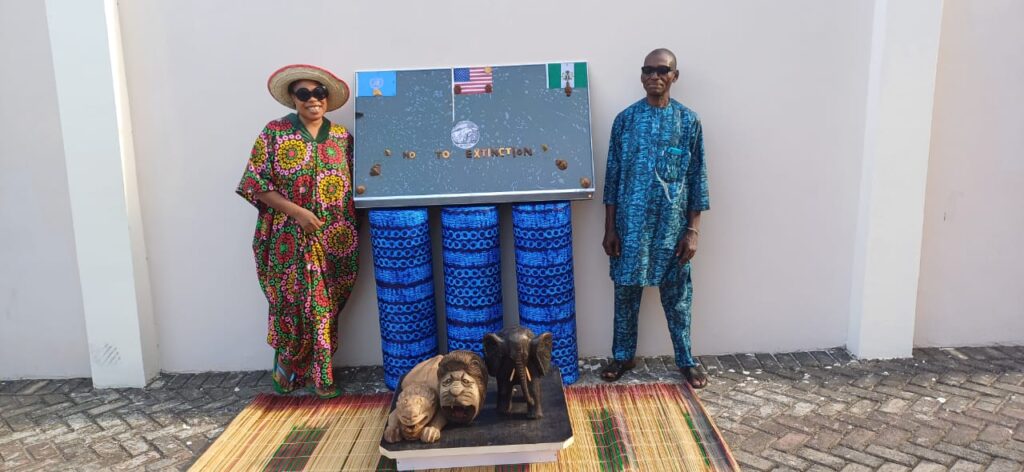Environmentalists across Nigeria have called on the African Union (AU) to adopt a robust policy for African wildlife conservation, prevent the extinction of African elephants, and promote the waste-to-wealth initiative through art.
Former Ondo State Commissioner for Environment, Funso Esan, and the State’s Goodwill Ambassador for Environment, Olayemi Olapeju, alongside other environmentalists, made the appeal during an environmental art initiative titled “No To Extinction or L’extinction.”
The initiative featured a scrapped Skyworth TV screen transformed into a priceless canvas to unveil American eagle coins thorncarving, aimed at raising awareness on wildlife conservation and waste-to-wealth creativity.
In his address, Esan urged the African Union to implement a strong conservation policy similar to the United States’ successful restoration of bald eagles, which were once on the brink of extinction but have since made a significant comeback.
He emphasized that habitat destruction and illegal poaching are responsible for the declining populations of African bush and forest elephants.
“Extinction is forever, and the endangered state of wildlife today means there is still hope for recovery. We need concerted efforts from both the government and the public to ensure the protection of our wildlife,” Esan remarked.
He further explained the significance of the thorncarving coins artwork, saying, “The artwork we are showcasing today features the majestic image of the United States’ bald eagle, affixed to the screen of a discarded Skyworth television.
“This represents both the waste-to-wealth initiative and the potential for endangered wildlife to make a comeback, just like the bald eagle did in America.
“In 2008, the U.S. government minted coins featuring the bald eagle to commemorate its return from endangerment.
“We hope that in the future, the African bush and forest elephants will also have a similar success story.”
Olayemi Olapeju explained that the artwork was created by No To Extinction or L’extinction artists from Ondo State to address the near extinction of African elephants and promote waste-to-wealth art.
She lamented that deforestation has significantly reduced the availability of thorn trees, which are essential for thorn carving.
According to her, it took almost two years to gather enough thorns for the artwork, which she and fellow artists Bolajoko Ayeni and Charles Olulaja Akeredolu, son of thorn carving inventor Akeredolu, used to reinvent the ancient craft.
“We used the eagle coins thorn carving to illustrate wildlife that has made a strong return from the brink of extinction.
“At the same time, we transformed a junked television screen into a valuable art canvas as part of our waste-to-wealth initiative to reduce the environmental impact of non-biodegradable electronics in landfills,” Olapeju said.
Charles Olulaja Akeredolu, a former art teacher at Methodist High School, Owo, noted that the scarcity of thorn trees is the biggest obstacle to preserving the thorn carving technique invented by his father in the 1930s.
He compared it to the invention of LEGO toys around the same period by Ole Kirk Kristiansen, adding that he is committed to reviving thorn carving as a unique art form.
Similarly, Bokajoko Taiwo Ayeni, an environmental artist, described thorn carving as eco-friendly, noting that it does not require cutting down trees, as only the thorns are harvested, allowing the tree to continue growing.
“Trees are a viable nature-based solution to climate change. All proceeds from the sale of thorn carving artwork will be used to plant more thorn trees, contributing to environmental sustainability while preserving this traditional craft,” Ayeni said.


















